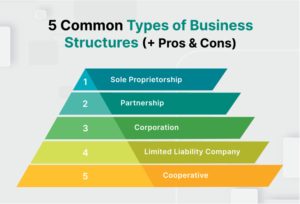
When starting a tech-based venture, one crucial aspect that often gets overlooked is determining the right business structure. A well-thought-out structure not only provides a legal foundation for your company but also affects your taxes, liability, and overall operational flexibility. In this article, we will delve into the various business structures and provide valuable advice to help you establish a solid foundation for your tech enterprise.
1. Sole Proprietorship
The simplest form of business structure is a sole proprietorship, ideal for tech entrepreneurs starting small or working individually. Operating as a sole proprietor offers complete control, minimal legal formalities, and easy tax reporting. However, it is essential to acknowledge that personal assets are at risk, and funding options may be limited.
2. Partnerships
If you plan to work with like-minded individuals in your tech venture, forming a partnership might be a viable option. General partnerships and limited partnerships offer different degrees of liability, management involvement, and profit sharing. Carefully evaluate your prospective partners and, ideally, consult an attorney to draft a partnership agreement defining each party’s rights, responsibilities, and expectations.
3. Limited Liability Company (LLC)
LLCs are popular choices for tech startups offering a balance between liability protection and simplicity. As an LLC owner, you are shielded from personal liability, allowing you to protect your assets while facilitating easier access to funding opportunities. LLCs offer flexible management structures, enabling you to assign roles and responsibilities within the organization.
4. Incorporation: C Corporations
For tech companies with ambitious growth plans or seeking external investments, forming a C Corporation is often recommended. C Corps provide strong liability protection and facilitate the issuance of various classes of stock, making it easier to secure funding from angel investors, venture capitalists, or even through an initial public offering (IPO).
5. Incorporation: S Corporations
S Corporations offer similar liability protection to C Corps but with added tax benefits. By electing S Corp status, your company’s profits and losses can pass directly to shareholders, avoiding the double taxation typically associated with C Corps. However, S Corporations have specific eligibility requirements, such as a limit on the number of shareholders and restrictions on the types of shareholders.
6. Professional Corporations
If you plan to offer professional services in the tech field, forming a professional corporation (PC) may be necessary. PCs protect individual professionals from personal liability arising from the malpractice of their partners or employees. However, it is essential to note that professional licensing requirements and regulations may vary depending on your specialization and jurisdiction.
7. Seeking Professional Assistance
While understanding the basics of business structures is helpful, seeking guidance from a qualified attorney or accountant is highly recommended. A professional can assess your unique circumstances, goals, and provide tailored advice on the best business structure that aligns with your tech venture’s objectives.
Conclusion
Establishing a solid business structure and formation is crucial for any tech-based enterprise. The right structure affects your legal obligations, tax responsibilities, and overall business flexibility. Evaluate the advantages, disadvantages, and long-term implications of each business structure carefully. Seek professional guidance to ensure you choose the most suitable option that protects your assets, aligns with your goals, and sets your tech business up for success.


